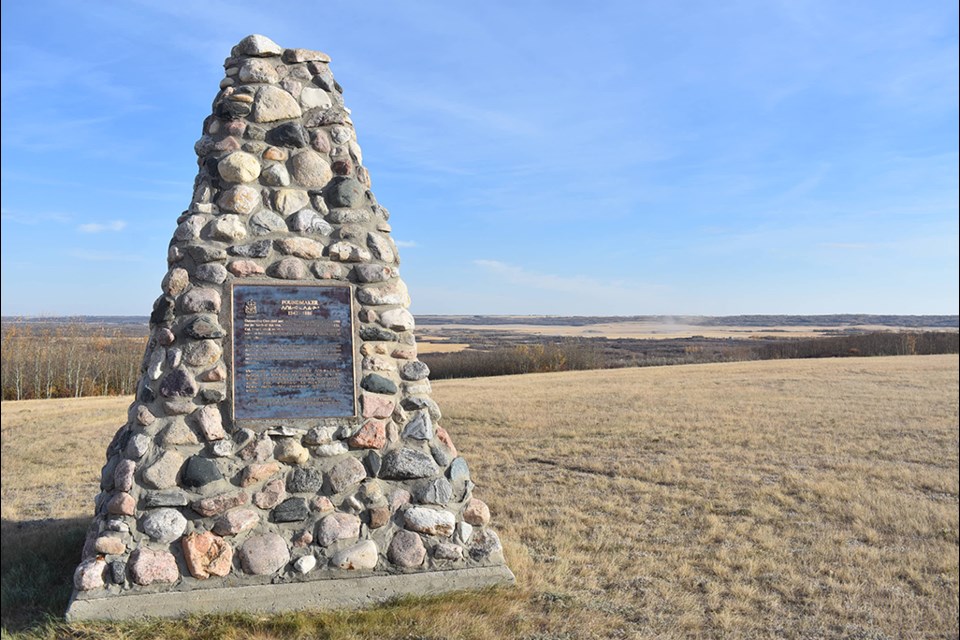POUNDMAKER CREE NATION — When Chief Poundmaker signed Treaty Six, he was clear about his position; it was the government’s responsibility to provide food for his people during times of famine.
Nine years later, in May 1885, Poundmaker and several First Nation bands tried to have Battleford Indian Agent Mr. Rae provide them with more rations. Unsuccessful, a group of young warriors raided the stores and private homes of Battleford citizens.
Seeking retribution without a direct order, Lt. Col. Otter formed a column of the Canadian militia and drove them west. On May 2, Otter launched a surprise attack on the people at Broken Knife’s Lookout in the early hours of the morning with more than 250 men.
Determined to defend his people, Poundmaker and his warriors pushed Otter and his men into a retreat within six hours. Then, Poundmaker convinced the warriors not to counter-attack and kill the retreating forces.
Chief Poundmaker and his men walked to Battleford in search of a peace agreement but were arrested. Poundmaker was charged with treason-felony, tried in Regina and a jury found him guilty in August.
Though sentenced to three years in Stony Mountain Penitentiary in Manitoba, Poundmaker was released a year later and walked to his adopted father in Alberta, dying just a few months later.
He is quoted as speaking at his trial,
“Everything that is bad has been laid against me this summer, there is nothing of it true. Had I wanted war, I would not be here now. I should be on the prairie. You did not catch me. I gave myself up. You have got me because I wanted justice.”
Today, on the land that once was the site of the battle that claimed nine lives, stands the Chief Poundmaker Museum and Historic Site. Founded in 1996 by the chief and council for Poundmaker Cree Nation, the museum was unused for years before its revival in 2016. It is now curated by author, playwright, and director of Miyawata Culture Inc., Floyd Favel.
“One of our first acts was to ask for the exoneration of Chief Poundmaker during our first-ever storytelling festival. So, the museum has played a central role in our community.” Favel said over email.
Chief Poundmaker was exonerated by Prime Minister Justin Trudeau in 2019 during an event at the museum.
The museum is devoted to preserving Indigenous history and the identity of the Poundmaker First Nation to strengthen and define its people. The museum also tells the story of the community and celebrates the people and families that have built the community into what it is today.
A sign inside the lobby of the museum reads, “It’s important that we take our own future into our hands, and this museum is just one of the ways we can demonstrate those ideas … This land is our legacy.”
The sign goes on to mark the importance of the elders who voiced their opinions, the band council for support and the original curators.
Inside, paintings by indigenous artists hang on the walls, and pictures of families dating back hundreds of years are presented. Outside, plaques and cairns mark the history behind the attack, and where Chief Poundmaker’s body was laid to rest in 1967.
To the north stands the Basil Favel Memorial teepee.
“… he was one of the principal fighters during the battle. What I want to do is expand the story of the battle to include other fighters from our community whose names are slowly 小蓝视频 lost, like Chatsis, Simaganis, Kasokeo, Antoine, Pyakutch as well as warriors and war chiefs from other communities who were present,” Favel said.
But Favel is more than a museum curator. East of the museum, on Poundmaker Cree Nation, is the Miyawata Culture Site, of which Favel is the director. Favel extended his gratitude to the chief and council as they are allowing him to build a site for festivals, ceremonies and cultural events, north of Wishtikan Lake.
“It is important that we commit to culture and language in a tangible way otherwise it can be lost.”
Teepees and a longhouse have already been built. Still, a lodge inspired by a Kidasta Earth Lodge, is currently 小蓝视频 erected, with plans well underway. The lodge has been designed by Alix Van Der Donckt Ferrand, a Peruvian Wendat artist from Montreal.
“I also have a domed lodge from the Anishinabe people, and that is for culture and language workshops. It is important that events take place in Indigenous structures, and structures inform our worldview and philosophy.”
The Chief Poundmaker Museum and Historical Centre s open during the summer months, but a tour can be scheduled during the winter. For more information, visit their .




